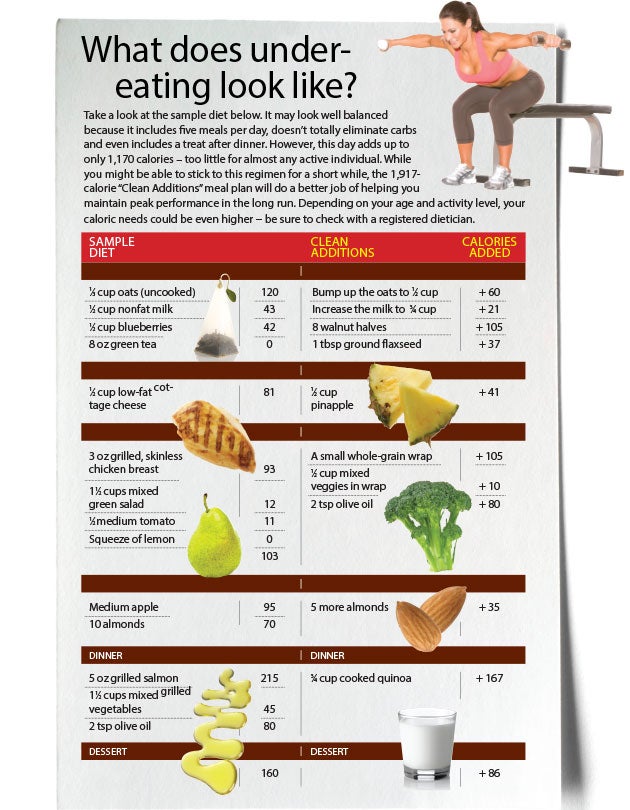Heading out the door? Read this article on the new Outside+ app available now on iOS devices for members! Download the app.

Like many active women, you’re mindful of your eating habits, watching every bite to make sure your hard work isn’t going to waste. But what would happen if you stopped seeing results? Your instinct might be to push a little harder at the gym and trim a bit more from your diet. (Maybe eight almonds is too many?) Cutting back on your eating while ramping up your workouts might seem like the logical thing to do when you want to shed more fat, but according to researchers, women who consistently eat less than what their body needs can not only stop seeing results, but also may see their health affected over time.
Fueling Your Metabolism
Your body needs enough energy to support all the basic processes that keep you alive — be it your organs functioning, your heart beating or your hair growing. The sum of these processes is known as your basal metabolic rate (what is often referred to as your metabolism), or BMR.
Once you get out of bed, however, you start burning energy through what is known as activities of daily living (ADL) – we’re talking about brushing your teeth, climbing the stairs or typing out an email. For a typical adult female, the total of BMR and ADL is about 1,800 calories per day, give or take a few hundred calories due to age, genetics or amount of lean muscle (more muscle means a higher BMR). That means you would need to eat an average of 1,800 calories per day to keep your weight stable — and this is assuming you aren’t even going to the gym.
When you add exercise into the equation, your energy needs can jump considerably. For more casual gym-goers, exercise might add up to a few hundred extra calories a few times per week, but for the truly hardcore, it could translate to a thousand calories or more per day. However, many women are reluctant to eat that much out of fear that they might gain unwanted weight or body fat.
Undereating Defined
So what happens if you eat less than your body needs? You’ll start by losing weight — at least for a while. But if you keep trimming your calories, your body will eventually adapt by reducing the amount of energy it burns to do everyday tasks, resulting in a drop in your metabolic rate.
Put another way, you start burning fewer calories at rest as your body tries to adapt to the lack of fuel. Keep it up over time, and your body will eventually harvest its own muscle, dragging your metabolism down even further. Beyond the effect on your biceps and metabolism, undereating can have other potentially serious consequences (see “5 Signs You’re Underfueled” for details). In a world where overeating and being overweight is the norm, it makes sense that active women want to be mindful of what they put in their body. But being overly cautious for too long could hinder your fat-loss goals and your health! The good news? According to research done on elite runners and gymnasts published in Medicine and Science in Sports and Exercise, the best-fueled athletes had lower body-fat percentages than those who were consistently undernourished.
5 Signs You’re Underfueled
Not sure if you’re undereating? A few warning signs that your engine might be running on empty:
1. You’re losing — or not gaining — muscle. The key dietary factors in muscle growth are calories and protein. If you’re working out hard and eating enough protein, but seem to be getting weaker or losing definition, your energy intake is low.
2. You’re tired all the time and you’re not sleeping well. If your body constantly lacks fuel, you’ll find it harder to recover from your workouts. Over time, undereating can also rob you of sleep, which is when you build and repair muscles.
3. You can’t get rid of that pesky belly fat. While it might seem to go against traditional weight-loss logic, it all boils down to metabolism and hormones: Undereating promotes muscle loss and rises in the levels of the belly-fattening stress hormone cortisol over time.
4. Your period stops, or becomes irregular. Yes, active women should still have their periods! If yours is becoming erratic (menopause aside) or has stopped entirely, or if you’re having trouble getting pregnant, it could be a sign that your body doesn’t have enough fuel to produce key reproductive hormones such as estrogen. (Note: Some forms of birth control may affect your period. Be sure to consult your doctor.)
5. Your bones are showing signs of weakness. If you’ve had a recent stress fracture or an unexpected broken bone from a fall, it could be a sign that your bones are weakening, a side effect of both low estrogen levels and inadequate calories. Over time, this could lead to osteopenia (reduced bone density) or full-blown osteoporosis.
Get Back On Track
So you have a hunch that you’ve been undereating. Now what? “Eat more”
seems like the obvious answer, but what exactly does that mean? Here are some strategies:
• Get a better idea of your input and output. While calorie counting can be a drag, using an online tool to track how many calories you are eating versus how much you are burning over a two- to three-week period is a good place to start. Your daily intake should not be consistently less than what you’re burning.
• Start gradually. Eating more can feel strange — and even uncomfortable — when you’ve trained yourself to get by on few calories, so take it slow. If your intake is far less than what you’re burning, try adding in just a few hundred more calories per day at a time, giving your body, and your appetite, time to adapt.
• Keep foods clean. Adding more fuel to your diet doesn’t mean picking up an order of fries the next time you’re out. Instead, add extra calories from fruit, nuts, avocados, whole grains, sweet potatoes and oily fish.
